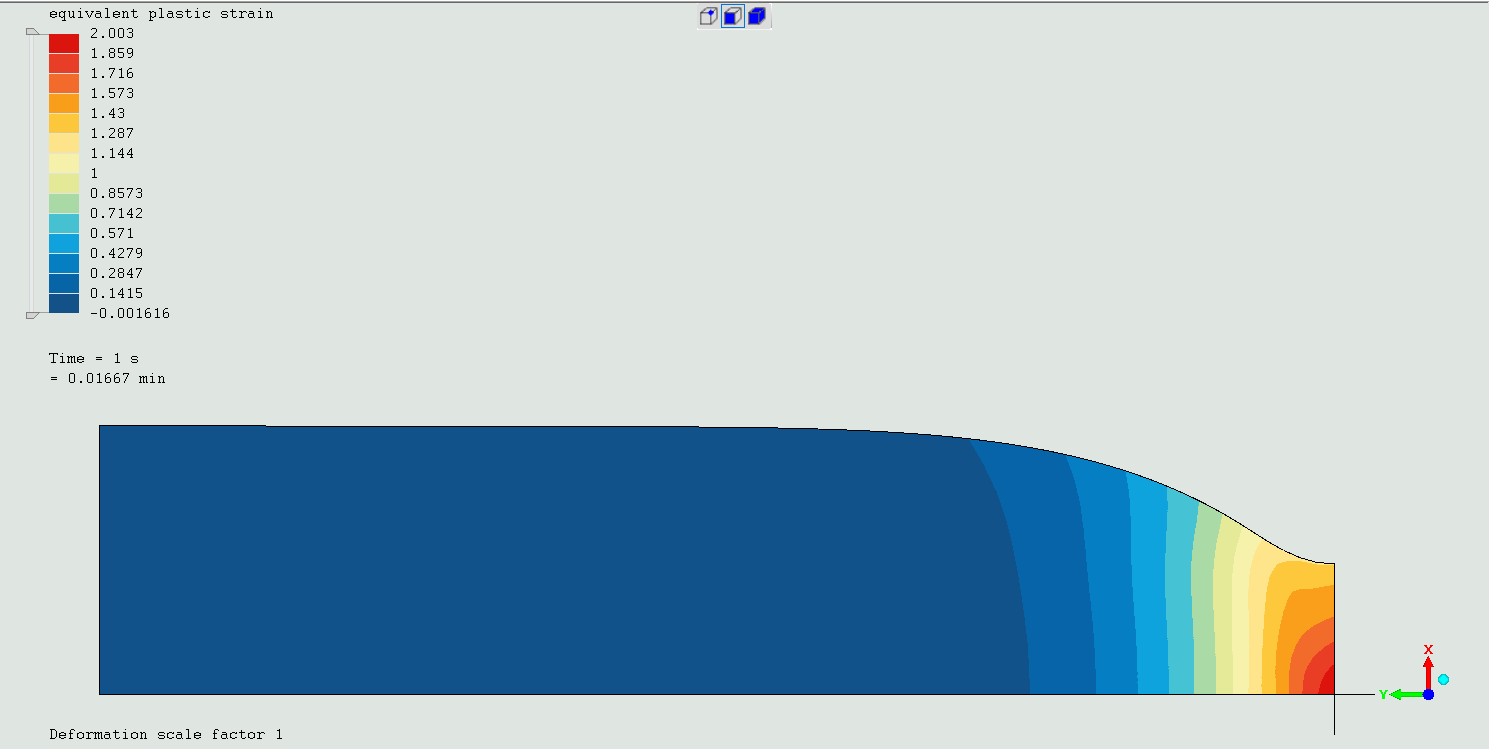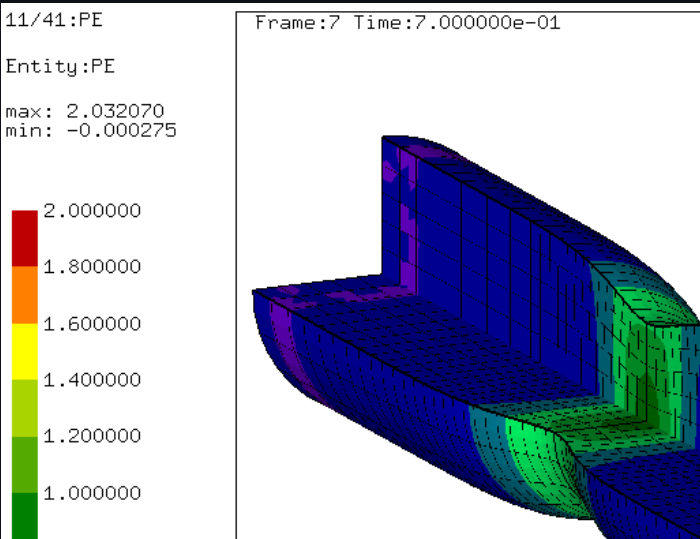Prof. Martin Kraska Tensile test of a wire
Hi,
I have set up Prof. Martin Kraska example “Tensile test of a wire” but with solid elements to check if the Nonlinear axisymmetric method using just an small slice agrees with the ccx axisymmetric CAX8R result.
The final equivalent plastic strain is 2.003 against 2.03 from Mr. Kraska.
https://github.com/calculix/CalculiX-Examples/tree/c6b5cc68fc5e868afe04ee312763779cad9302ef/Drahtbiegen/Zug
Raise your hand who, like me, would be interested in Victor implementing the real axisymmetric nonlinear analysis for ccx. Contacts included. (Vessels, tanks, ....)
ccx 2.20.Pastix. 01:19 min
Please comment if someone sees something wrong or missing. Perfect plasticity with custom cards.


I have set up Prof. Martin Kraska example “Tensile test of a wire” but with solid elements to check if the Nonlinear axisymmetric method using just an small slice agrees with the ccx axisymmetric CAX8R result.
The final equivalent plastic strain is 2.003 against 2.03 from Mr. Kraska.
https://github.com/calculix/CalculiX-Examples/tree/c6b5cc68fc5e868afe04ee312763779cad9302ef/Drahtbiegen/Zug
Raise your hand who, like me, would be interested in Victor implementing the real axisymmetric nonlinear analysis for ccx. Contacts included. (Vessels, tanks, ....)
ccx 2.20.Pastix. 01:19 min
Please comment if someone sees something wrong or missing. Perfect plasticity with custom cards.


Howdy, Stranger!
It looks like you're new here. If you want to get involved, click one of these buttons!


Comments
I do a lot of work with axisymmetric geometry and generally use the thin sector and frictionless support (or similar) technique so have a lot of interest in whether this is producing valid results.
I'm struggling to understand how there could be a significant difference between the 'real' axisymmetric model and the thin sector approach, but I'm not an FEA specialist.
@disla, have you tried running a version of your test case as a full 3D model? I realise that would be a lot bigger model but might narrow down the range of possibilities where the discrepancy is coming from.
I was going to try it myself, and still might give it a go, but I'm not familiar enough with customising CCX keywords.
In this sense, this method could improve the “pure” axisymmetric approach as you can revolve with more than 1 element per “thickness” capturing better the through thickness stresses.
You don't need customization to compare with the full model. Just use the same file but revolve to complete the whole cylinder. Then remove frictionless as you don’t need them.
Prepomax has 2D Axisymmetric if I’m not wrong. You can compare both results.
Be careful with frictionless support. When applied to linear elements or sloped surfaces it can give unexpected results. I would better use (-y,x,0) to constrain rotations.
Eight-node axisymmetric element (CAX8 and CAX8R)
"The axisymmetric structure is expanded by rotation about the second coordinate axis, half clockwise and half counterclockwise."
"the expansion creates only one layer of elements. CalculiX uses an expansion angle of 2º"
I used "Rotate/copy..." to create a full 3D model of the wire from the model in the first post of this discussion. As expected this resulted in a very large model, even after "Merge nearby nodes...". I left it running over a weekend but it didn't make much progress. The time step kept being adjusted.
I did have some concerns that the C3D20 elements brick elements end up with nodes at the same points at axis of rotation, but that's probably just my lack of understanding.
My main concern is that there is a discrepancy being reported in the original post, but am not able to fully interrogate either to understand and verify they are the same. I appreciate that the models have been created by people who are far better than me at this sort of thing but I'd like to do a basic comparison.
I haven't seen a description of the study (dimensions, material properties, etc.) other than that in the model files, another reason for wanting to understand the cards.
As pointed out, CalculiX creates a sector of solid elements from an axisymmetric study so it's using the same principle. If the principle is wrong then would using CAX8 help?
Perhaps modifying the model to replicate 2° C3D20 elements would be useful?
I can only think of a couple of possible causes:
- there is a difference in the models (material properties, dimensions, loads, etc.)
- the constraints are working differently
I'm sure there are more possibilities but can't think of them at the moment.
I understand your concern. This is how I would proceed.
1-The fact that too solutions are the same (full/slice, slice/axisymmetric) doesn’t mean the solution is right unless one is validated.
You need an analytical solution to compare, preferably a problem similar to the one you daily work with.
2-The slice BC, ¼, or ½ symmetry condition are essentially the same. Your question is worth to be answered. I would start with ¼. That will tell you if your BC are right to represent the full model.
3-Start with few elements and Static analysis. Go to complexity only if your discrepancy is under control.
Hopefully the discrepancy with the full model will be known and reduced as much as possible. Then you can decide if it’s worth known that Mecway doesn’t have Axisymmetric Nonlinear and full model takes one weekend.
Analytical solutions for finite cylinders compressed between platens (3. Homogeneous stress and strain without end friction)
https://www.sciencedirect.com/science/article/pii/S0020768307002284#fd3
Now you could try the sliced approach and see if you get the same result.
Let us know what you get. It’s always useful to have validation files as reference.